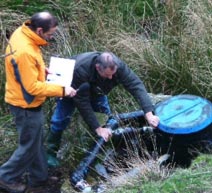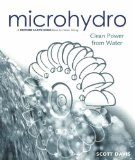
Off the grid and up for rent
Are you technically minded, a bit creative, looking for a challenge, and a beautiful place to live off-grid? We may have the answer:
One of the biggest off-grid property bargains in the country is just about to come on the market. David Allender and his wife Muriel have turned their isolated farmhouse in the beauty spot of Bolton Abbey in the Yorkshire Dales into a stunning off-grid residence over the last 15 years. The Allenders are leaving for Spain next month, and we want to help them find someone who can keep the property up in its present condition. If you are interested, leave a comment at the end of this article and we will pass it on to David, or email nick@off-grid.net.
Allender is only asking 3,500 for all the renewable energy fittings he has put in over the past decade, including 2 wind turbines, a micro-hydro setup, some solar panels, three inverters, 2 backup diesel generators and 24 ex telephone exchange batteries. The Allenders run a washing machine, iron, computer, TV, stereo and all their lights off that little lot.
The Allenders pay just 175 a month rent. The owners will try to hike up the rent. This article sets out all the hidden costs and responsibilities interested parties will need to know when negotiating with them. (Please click more for rest of story and pics)
The ideal person take it up would be someone quite technical who works from home, said Allender. A writer or an artist, someone who is not to-ing and fro-ing all the time. Its not impossible with children. We brought our daughter up here. The school bus would be willing to pick up from the bottom of the track.

Allender shows microhydro setup to BBC’s Roger Harrabin
The sturdy 3-bed house with its collection of stone outhouses and barn, is up a 2 mile track. It gets cold at 1000 feet above sea level, and that means their annual heating bill if they had one would be at least 1200. Plus no water rates as their water is from a local spring maintained by the landlord.
But there are costs as well. The track from the road needs annual maintenance (shared between the landlord and a local farmer). Allender spreads the new gravel each year. It takes him a couple of hours a night from February to May. It also takes a heavy toll on wheels, tyres and suspension. Muriel Allender reckons it costs them up to 1000 some winters in car maintenance, not to mention the extra petrol for all those two mile drives to and fro. The energy generating equipment also needs maintenance, and unless you are at home with the technology like David that might set you back a bit more than the 300 a year he reckons it costs him. The backup generators use about 200 a year in red diesel, and the fuel oil to run the Raeburn is delivered by truck into the large green bubble you can see in one of the photos. They had their last delivery two years ago and are not through it yet. The Raeburn itself needs maintenance, though the Allenders just spent 1000 on a new boiler, so that is unlikely to need replacing for at least a decade.
 Microhydro: Clean Power from Water – buy it from Amazon UK – only 10 (and we get 4%)
Microhydro: Clean Power from Water – buy it from Amazon UK – only 10 (and we get 4%)
When Allender first moved in he was working for IBM computers, but he was a practical man with an engineering background and he decided to acquire a small wind turbine, a diesel generator and a battery to store the generated power.
The arrangement worked OK but he was surprised to find how many windless days there are in January even at 1000 ft. above sea level in the Pennines!
There is a small moorland stream that flows past the farmhouse and he wondered if that resource could be harnessed to generate power. The stream floods in winter but reduces to a trickle in the summer. There are no fish in the stream as it is too acidic and also there are 2 waterfalls downstream blocking their way.
It soon became apparent that what I needed was a water turbine, not a water wheel. A water wheel is fine for grinding corn or sharpening blades but not very efficient at generating electricity. As a water wheel turns slowly it would require a lot of gearing to turn an alternator at a sufficient speed to generate power, although some people have used this method.
General principles
The basic principle of hydro electricity is that if water can be piped from one level to a lower level, the resulting water pressure can be converted into mechanical energy and then to electrical energy.
How much power could I generate from the stream?
Apparently it all depended on two things, the head i.e. the actual height that the water falls through and the flow rate of the stream. There is a formula that can be used to calculate the power (in watts), it is P = 10 x Q x H where H represents the head (in metres) and Q = flow in litres/second.
The head and flow had to be measured. There are several ways to measure the head depending what equipment is available. The most accurate is to use a dumpy level (builders level) or a theodolite, but the simplest is to use a spirit level and a plank, but this is only suitable on low head sites, and is not very accurate. Needless to say I used the spirit level and plank method. The head was found to be 8 metres over a horizontal distance of 170 metres.
The flow can be measured in several ways depending upon the size of the flow. For small hydro schemes a measuring weir can be used. The buckets method is a simple way of measuring flow in small streams whereby the entire flow is diverted into a bucket and the time for it to fill is recorded. I used the measuring weir method. The flow varied from a minimum of 1 litre/sec in summer to over 80 litres/sec in winter. It rarely fell below 5 litres/sec between October and April.
Using the above mentioned formula, and assuming a flow of 5 litres/sec, the expected power output would be P = 10 x 5 x8 = 400 watts. However, as nothing is 100% efficient, energy would be lost in the pipework, turbine and alternator, so 200 watts would be likely output.
Seeing that the site could be used for a micro-hydro system and would provide useful power I decided that I needed to do 2 things. The first was to seek the required permissions from the
land and water authorities and the second was to bounce my ideas off the experts, so I attended a weekend course at CAT on water power. I came back with a few publications from their excellent bookshop, a lot of notes, some valuable experience and a lot of enthusiasm.
One of the publications I obtained at CAT was a book entitled ‘Micro-Hydro Power” published by IT Publications Ltd. ISBN 1-85339-029-1. This book is a mine of information, most of it practical and comes highly recommended. In appendix B of the book can be found Product details and addresses of suppliers and manufacturers of Micro-Hydro equipment. I selected several of the suppliers and wrote to them requesting information and supplying them with International Reply Coupons to cover their costs because all of them were abroad.
Not all replied, but from those that did, I eventually chose a turbine supplied by Dependable Turbines, Port Moody, Canada. It was a vertical turgo turbine built by Energy Systems and Design It had 4 nozzles, enabling it to cope with a variety of flows, costing 1360 Canadian Dollars + import duty.
Construction
Whilst waiting for the turbine to arrive, I started work on the weir intake and installation of the penstock. The stream had to be dammed for half of its width with sandbags until I could get he foundations for the weir in place. I then moved the dam over the new foundations and finished them off across the full width of the stream. Concrete blocks were then built onto the foundations to a height of 2ft. All of the work was carried out in summer to take advantage of the low flow of the stream.
The penstock was made up of 4″ dia PVC tubing. It was dielivered in 6 metre lengths and thus required many joints to be made. I used solvent weld connectors because they were cheaper than the alternatives. The penstock was buried for about half its length adjacent to the house but was fixed on the surface for the remaining distance, via a system of brackets and stone supports.
A concrete base was made for the turbine into which a removable frame was mounted to which the turbine was bolted. To connect up the turbine to the battery required about 150 metres of 6mm cable. This six mm cable was required to prevent too much voltage drop along the length of the cable and hence loss of power.
The time eventually came to test the installation. I removed the piece of car wheel innertube blocking the penstock and allowed the stream water to cascade down the penstock to the turbine. The turbine started turning but unfortunately, no output was shown on the meter. I closed all the valves on the turbine which immediately sent a 10′ high fountain of water shooting up the air vent tubes. This went on for about 10 minutes until all the air had been purged from the penstock. When I opened the valves on the turbine this time the output meter read 10 amps – i.e. 250 watts output – Hoorah!
Living with Micro-Hydro
The first season’ ran from September to May and the turbine ran almost non-stop for 8 months, there were occasions during the first winter when the water was flowing well and the wind was blowing strongly so that I had too much power! The 24v battery was up at 30 volts. I encouraged the wife to do the ironing (normally reserved for evenings when the diesel is running) and didn’t object to my daughter’s stereo on full blast
– the nearest neighbours are 2 miles away, or to leaving lights turned on.
The turbine was checked at the end of the season. The alternator brushes were checked and due to a fault with one of the brushes, it was discovered that one of the slip rings in the alternator has disintegrated. I had it repaid at a local auto electrician. Hopefully the problem will not re-occur.
After heavy rainfall, it was sometimes necessary to clear the rash rack of debris that had accumulated. If it was left. the level of the water in the forbay fell and allowed air to be drawn into the penstock which dramatically reduces the power output.
The cold weather in December 1995 caused 2 of the metal valves that connect the penstock to the turbine to fracture. I replaced them and managed to repair the cracked ones so I now have 2 spares. the rest of the installation stood up well to the temperatures of -20 centigrade probably due to the fact that the turbine was running with 2 of the 4 valves open.
Has it been worth it? Well if mains electricity had been available the answer would be no. But seeing I had little alternative things have worked out well. During the first season of use (8 months), I calculate that the turbine has generated approx. 1400 KwH of power – quite an amount. The power is certainly not free of course – the capital cost will not be paid off for about 10 years. However the experience has been useful and one important fact that should not be overlooked is that the turbine is totally non-polluting.
November 2000 – The turbine is still producing the bulk of the power for the house. Every year during the ‘dry’ months in the summer, I have had the slip-ring and brushes replaced. The only other required maintenance is keeping the trash rack that is situated above the collecting tank free of debris. This needs watching closely after periods of heavy rain. If rubbish (trash) gets washed down, it usually clogs up the turbine wheel and/or blocks the flow into the tank. Either way the turbine has to be stopped, rubbish cleared away, penstock purged of air and then restarted. On a couple of occasions I have had to dismantle the end of the penstock adjacent to the turbine to remove some rubbish.
August 2002 Latest Update: The output from the turbine has been steadily decreasing over the years. Some tests I did showed that each turbine jet on its own was producing the same power as when the turbine was installed. However, when all the jets were in use, a reduced power level was seen. This indicates a problem with the water flow, probably a restriction or blockage. During the time that the turbine was being overhauled I took the opportunity of cleaning the penstock. I did this by allowing a nylon rope to be drawn down the penstock with the flow of water. I then tied a ball of ‘netlon’ nylon garden netting to the end of the rope at the top of the penstock and then pulled it through from the bottom. Needless to say I got covered in filth as the accumulated silt suddenly was shot from the end of the penstock ! The turbine is now back to its original output. The moral of the story is to remember to clean the penstock occasionally.
One Response
Hi,
My name is Chris Kirkham.
I have been thinking very deeply about ways to become self sufficient in energy and remove relaince on profiteering energy companies as well as do our bit for the Earth.
We have installed Solar water heating and we are amazed at the effectiveness of the system.
We want to do more and on reading the article were excited by the prospect.
I am a textile chemist and i work from home .My technical background and practical nature gives me the tools to be able to cope with the mechanicals of the systems.
The Wharfe valley is also one of my favourite places in the world.
Doubtless you will be inundated after the article.All i would say is we are genuine and would care for the place as you have done.
Please get in touch but if not good luck in Spain.
Regards
Chris Kirkham